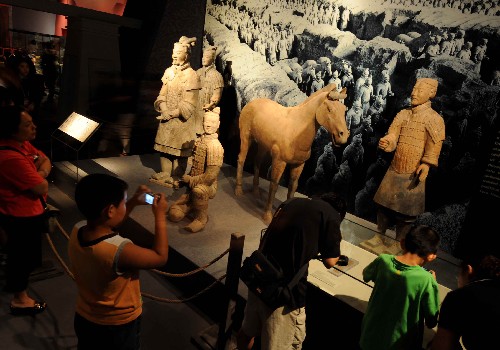The world-famous terra cotta warriors and horses, which were buried more than 2,200 years ago as the army guarding China's first emperor's afterlife, have come to Beijing for an exhibition ahead of the Olympics.
Set in the Capital Museum, the exhibition, "the memory of China: treasures along its 5,000-year civilization", is open to the public on Tuesday. It will run to October 7.
"It's the best greeting from the ancient country to the modern Olympics," said Yao An, vice president of the Museum. The exhibition was a long-time plan by the Chinese heritage system to welcome the Olympics, said Yao.
|

|
|
Visitors come to visit the exhibition "the memory of China: treasures along its 5,000-year civilization" at the Capital Museum yesterday. The exhibition is open to the public on July 29 and will run to October 7.
|
Coming from northwest China's Xi'an City, the terra cotta warriors and horses are the mortuary objects of Emperor Qinshihuang, China's first emperor in the Qin Dynasty (221 B.C.- 207 B.C.). It is widely viewed as the Eighth Wonder of the ancient world.
The terra cotta warriors now on show include a general, an officer, a warrior, a squatting archer and a warhorse. Standing at the center of exhibition hall, the group of military staff drew most of the spectators' attention.
"It's amazing," said an American spectator, Scott Dunford, "It's well known worldwide. Although I've never been to Xi'an, but I see them in Beijing now."
Along with the terra cotta warriors, 169 pieces of China's most precious ancient relics from 55 provincial museums, such as silk painting dating back to 2,000 years ago, and a jade burial suit, are also on show in the exhibition.
The oldest item, a sun god sculpture, can be traced back 7,000 years, while an imperial enamel incense burner in Qing Dynasty (1644-1911), is the most modern item on display.
"The exhibition is the first time that China's 5,000-year history has been explained just with artifacts," said Zhang Jie, planner of the exhibition, "it is of special significance, as the Chinese civilization is the only one which has never been interrupted."
In order to protect these fragile items, workers said all the lighting were specially treated with ultraviolet filters.
"Nothing but the Olympics could bring such a gathering of ancient treasures together," said spectator Zhou Jing.
Useful inf:
Open hours: 9:00 to 17:00 (Closed on Monday)
Ticket: 30 yuan; (Free admission for regular exhibitions if you reserve 3 days in advance. 4000 admissions everyday.)
Reservation: By online at http://www.capitalmuseum.org.cn/en/reservation.htm or by phone via 010-63393339 for group visitors more than 10 (in Chinese, English and Japaness) between 9:00-17:00.
How to get there: Subway: Muxidi Station, Line 1; to take bus No.1, No.4, No.52 and No.37 to the stop "Gonghuidalou"; No.937, No.727, No.717, No.650, No.708, No.26, No.319 to the stop Baiyunlu; Special Bus No. 1 to the stop "Muxidi"
Tel: 010-63370491 63370492
Website: http://www.capitalmuseum.org.cn/en/index.htm